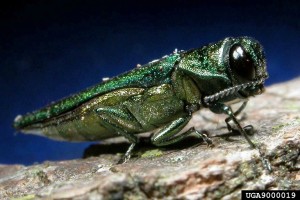Emerald Ash Borer Found in NC
go.ncsu.edu/readext?224201
en Español / em Português
El inglés es el idioma de control de esta página. En la medida en que haya algún conflicto entre la traducción al inglés y la traducción, el inglés prevalece.
Al hacer clic en el enlace de traducción se activa un servicio de traducción gratuito para convertir la página al español. Al igual que con cualquier traducción por Internet, la conversión no es sensible al contexto y puede que no traduzca el texto en su significado original. NC State Extension no garantiza la exactitud del texto traducido. Por favor, tenga en cuenta que algunas aplicaciones y/o servicios pueden no funcionar como se espera cuando se traducen.
Português
Inglês é o idioma de controle desta página. Na medida que haja algum conflito entre o texto original em Inglês e a tradução, o Inglês prevalece.
Ao clicar no link de tradução, um serviço gratuito de tradução será ativado para converter a página para o Português. Como em qualquer tradução pela internet, a conversão não é sensivel ao contexto e pode não ocorrer a tradução para o significado orginal. O serviço de Extensão da Carolina do Norte (NC State Extension) não garante a exatidão do texto traduzido. Por favor, observe que algumas funções ou serviços podem não funcionar como esperado após a tradução.
English
English is the controlling language of this page. To the extent there is any conflict between the English text and the translation, English controls.
Clicking on the translation link activates a free translation service to convert the page to Spanish. As with any Internet translation, the conversion is not context-sensitive and may not translate the text to its original meaning. NC State Extension does not guarantee the accuracy of the translated text. Please note that some applications and/or services may not function as expected when translated.
Collapse ▲Emerald ash borer (EAB) has been detected in North Carolina for the first time. The detection was made in Granville County with the collection of an adult beetle that was confirmed by taxonomists. Several other sites in Granville County also had trees with classic signs and symptoms of EAB including D-shaped exit holes, meandering galleries, dieback and thinning crowns, epicormic sprouting, vertical bark splitting, and increased woodpecker activity. There were trees in Person and Vance County that displayed positive signs also. Pictures of what is described above can be found at: http://na.fs.fed.us/spfo/pubs/pest_al/eab/eab.pdf .
On the NCFS Forest Health webpage is a link to Frequently Asked Questions related to EAB with links to additional information. http://www.ncforestservice.gov/forest_health/fh_eabfaq.htm . Most information you might need can be found here.
Because of the serious nature of this invasive pest, a quarantine has been implemented for Granville, Person and Vance Counties. This quarantine will restrict the movement of ash trees, ash logs, etc. from these counties to other areas of the state. It will also restrict the movement of hardwood firewood from these areas. These are the same as those imposed in other states where EAB has been found as this is a federally regulated pest. If you want to know more about regulations/quarantines, contact the NCDA Plant Industry Division directly.
Forest Health staff will be conducting training/field workshops for NCFS personnel and others working in forestry, natural resource management and horticulture in and around affected counties in the near future. These will highlight EAB awareness, identification, life cycle and control, including field visits to some positive sites.
Under natural conditions, EAB spreads about 5 miles per year. However, it has spread longer distances in short periods hitchhiking on firewood, prompting a nationwide campaign to encourage people not to move firewood, or to buy firewood from local or certified sources. This has been found to be the most effective way to slow the spread of this pest.
Information provided by Robert P. Trickel, NC Forestry Service, Forest Health Branch Head, NC Registered Forester No. 1071




